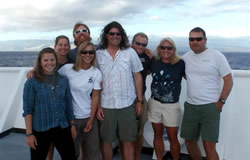2010 Explorations in the Monument
In May and June of 2010, maritime heritage was the lead mission of the 2010 Explorations in the Monument 25 day research expedition to the NWHI. The eight person maritime heritage team included three smaller teams: a two person remote sensing team running side scan sonar and magnetometer operations at each atoll from the NOAA small boat HI-2, a three person ecological assessment team conducting a biogeographical study on maritime heritage sites in the Monument, and a three person maritime archaeology team conducting site survey, documentation and interpretation of new and known maritime heritage sites in the Monument.
Over the course of 25 days, the team visited: French Frigate Shoals, Lisianski, Pearl and Hermes Atoll, Kure Atoll, Midway Atoll and Nihoa. Personnel included PMNM maritime heritage coordinator Dr. Kelly Gleason, Jason Raupp of Flinders University, Alysia Curdts, Derek Smith, Nyssa Silbiger and Anne Rosinski of the Hawaii Institute of Marine Biology and Michael Krivor and Jason Burns of SEARCH, Inc. While at French Frigate Shoals, the maritime archaeology team (Gleason, Raupp and Curdts) continued documentation of the site of an early 19th century whaling ship discovered during the 2008 expedition to the NWHI. This is likely the site of one of three American whaleships lost at French Frigate Shoals in the 1800s. Discovery of dozens of new artifacts including several whaling harpoon tips, lances, datable ceramics, kitchenware, bottle glass, an early 19th century sounding lead, rigging, blubber hooks and ballast give the team a wealth of new information that they will use to narrow down the identity of this fascinating whaling ship site. Work at the site included the recovery of one of the five whaling harpoon tips discovered for the purposes of analysis, treatment, and interpretation. Harpoons were usually etched with the name of the ship and maker, so there is hope that careful treatment of this artifact and the creation of a mold of the artifact will yield significant information about the site. The team created a site plan documenting the location and distribution of artifacts in an area of the site discovered during survey in 2009. Additionally, the team documented a total of four new vessels during two days of work at Lisianski including a large section of a late 19th century wooden hulled sailing vessel.
Remote sensing specialists from SEARCH, Inc. (Krivor and Burns) covered approximately 300 line miles of survey over the course of 15 days of survey. In addition to searching for new wrecks, the remote sensing team surveyed the extent of areas of new sites successfully determining the extent of these wreck sites. Side scan sonar mosaics will be created that have multidisciplinary utility and contribute to broader mapping efforts in the Monument with refined areas of survey.
Over the course of the 25 day expedition, the ecological assessment team (Smith, Silbiger and Rosinski) compiled an understanding of the environment surrounding 6 maritime heritage sites that span over 180 years of maritime heritage in the Monument. The team conducted 35 transects that included fish species richness and abundance, rugosity and benthic community structure. The team also collected five days of continuous oceanographic data, retrieved and deployed data loggers, and collected coral samples for genetic analysis and connectivity research.
The success of the cruise, and the continued broadening of the maritime heritage research efforts in the Monument are the result of the tremendous effort and dedication on behalf of the maritime heritage team who participated in the 2010 Explorations cruise to Papahānaumokuākea.

